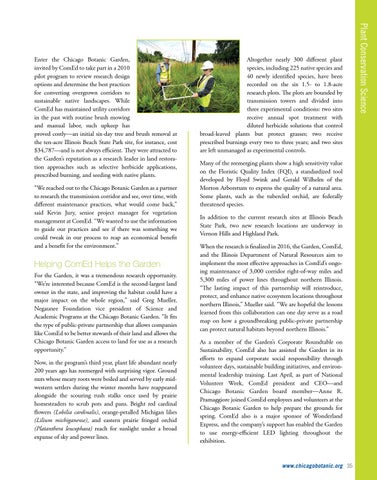“We reached out to the Chicago Botanic Garden as a partner to research the transmission corridor and see, over time, with different maintenance practices, what would come back,” said Kevin Jury, senior project manager for vegetation management at ComEd. “We wanted to use the information to guide our practices and see if there was something we could tweak in our process to reap an economical benefit and a benefit for the environment.”
Helping ComEd Helps the Garden For the Garden, it was a tremendous research opportunity. “We’re interested because ComEd is the second-largest land owner in the state, and improving the habitat could have a major impact on the whole region,” said Greg Mueller, Negaunee Foundation vice president of Science and Academic Programs at the Chicago Botanic Garden. “It fits the type of public-private partnership that allows companies like ComEd to be better stewards of their land and allows the Chicago Botanic Garden access to land for use as a research opportunity.” Now, in the program’s third year, plant life abundant nearly 200 years ago has reemerged with surprising vigor. Ground nuts whose meaty roots were boiled and served by early midwestern settlers during the winter months have reappeared alongside the scouring rush stalks once used by prairie homesteaders to scrub pots and pans. Bright red cardinal flowers (Lobilia cardinalis), orange-petalled Michigan lilies (Lilium michiganense), and eastern prairie fringed orchid (Platanthera leucophaea) reach for sunlight under a broad expanse of sky and power lines.
Altogether nearly 300 different plant species, including 225 native species and 40 newly identified species, have been recorded on the six 1.5- to 1.8-acre research plots. The plots are bounded by transmission towers and divided into three experimental conditions: two sites receive annual spot treatment with diluted herbicide solutions that control broad-leaved plants but protect grasses; two receive prescribed burnings every two to three years; and two sites are left unmanaged as experimental controls. Many of the reemerging plants show a high sensitivity value on the Floristic Quality Index (FQI), a standardized tool developed by Floyd Swink and Gerald Wilhelm of the Morton Arboretum to express the quality of a natural area. Some plants, such as the tubercled orchid, are federally threatened species. In addition to the current research sites at Illinois Beach State Park, two new research locations are underway in Vernon Hills and Highland Park. When the research is finalized in 2016, the Garden, ComEd, and the Illinois Department of Natural Resources aim to implement the most effective approaches in ComEd’s ongoing maintenance of 3,000 corridor right-of-way miles and 5,300 miles of power lines throughout northern Illinois. “The lasting impact of this partnership will reintroduce, protect, and enhance native ecosystem locations throughout northern Illinois,” Mueller said. “We are hopeful the lessons learned from this collaboration can one day serve as a road map on how a groundbreaking public-private partnership can protect natural habitats beyond northern Illinois.” As a member of the Garden’s Corporate Roundtable on Sustainability, ComEd also has assisted the Garden in its efforts to expand corporate social responsibility through volunteer days, sustainable building initiatives, and environmental leadership training. Last April, as part of National Volunteer Week, ComEd president and CEO—and Chicago Botanic Garden board member—Anne R. Pramaggiore joined ComEd employees and volunteers at the Chicago Botanic Garden to help prepare the grounds for spring. ComEd also is a major sponsor of Wonderland Express, and the company’s support has enabled the Garden to use energy-efficient LED lighting throughout the exhibition.
www.chicagobotanic.org 35
Plant Conservation Science
Enter the Chicago Botanic Garden, invited by ComEd to take part in a 2010 pilot program to review research design options and determine the best practices for converting overgrown corridors to sustainable native landscapes. While ComEd has maintained utility corridors in the past with routine brush mowing and manual labor, such upkeep has proved costly—an initial six-day tree and brush removal at the ten-acre Illinois Beach State Park site, for instance, cost $34,787—and is not always efficient. They were attracted to the Garden’s reputation as a research leader in land restoration approaches such as selective herbicide applications, prescribed burning, and seeding with native plants.
